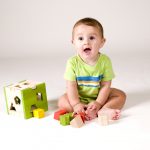 Around this month, babies start figuring out how to get around, often in combinations of movement. Some army crawl, some attempt to get up to a traditional crawling position, others will just get better at rolling over and over, and still others learn to scoot on their bottom (called bottom shuffling). Most babies will be able to balance while in a seated position, using their hands to reach for toys instead of using them as support.
Around this month, babies start figuring out how to get around, often in combinations of movement. Some army crawl, some attempt to get up to a traditional crawling position, others will just get better at rolling over and over, and still others learn to scoot on their bottom (called bottom shuffling). Most babies will be able to balance while in a seated position, using their hands to reach for toys instead of using them as support.
Their bi-manual coordination allows them to hold two objects simultaneously and bang them together. They will also be able to grab thinner objects and might even start developing a pincer grasp (a hold using the thumb and index finger). As they get more comfortable manipulating objects, they may throw things from the crib or purposely drop objects on the floor to get someone to pick them up.
You will also notice that your baby will incorporate more facial expressions and will imitate children and adults to express sadness, joy, or just for fun.
Separation anxiety might also start around this time, but will likely peak after 10 months. Babies are now aware that their mother is a separate entity that can leave them. There is a natural aversion to being apart from the person who is often viewed as the primary protector.
Back







